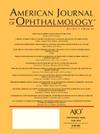Two novel extended depth-of-focus intraocular lenses targeted for mini-monovision: A prospective randomized controlled trial
IF 4.1
1区 医学
Q1 OPHTHALMOLOGY
引用次数: 0
Abstract
Purpose
To compare the visual outcomes of two extended depth-of-focus (EDOF) intraocular lenses (IOLs).
Design
Single-center prospective randomized controlled trial.
Methods
Patients undergoing bilateral cataract surgery were randomly assigned to receive either the Acunex Vario IOL (Teleon Surgical B.V., Spankeren, The Netherlands) or the AcrySof IQ Vivity IOL (Alcon Laboratories Inc., Fort Worth, United States of America); both Vario-group and Vivity-group were targeted for mini-monovision. The primary outcome was the uncorrected intermediate visual acuity (UIVA, measured at 66cm). Secondary outcome parameters were uncorrected distance visual acuity (UDVA), uncorrected near visual acuity (UNVA), defocus curves, reading speed, contrast sensitivity, spectacle independence and quality of vision.
Setting
University Eye Clinic, Maastricht University Medical Center+, the Netherlands.
Results
A total of 31 subjects (62 eyes) were included, 16 patients were enrolled into the Vario-group and 15 patients into the Vivity-group. At three months postoperatively, no statistically significant differences were found for the binocular visual acuities between the groups after adjustment for covariates. The mean and standard deviation for the binocular UIVA was 0.04±0.11 and 0.15±0.11 logMAR (adjusted-P=0.264) for the Vario-group and Vivity-group, respectively. The binocular UDVA was 0.00±0.14 and 0.08±0.10 logMAR (adjusted-P=0.753), and UNVA was 0.22±0.17 and 0.31±0.14 logMAR (adjusted-P=0.235), for both groups, respectively. While the Vario-group had a larger range of defocus, no significant differences were found for patient satisfaction and spectacle independence. Contrast sensitivity and reading speed were comparable, and there were no statistically significant differences in optical side effects between the groups.
Conclusion
Bilateral implantation of the Acunex Vario IOL and the AcrySof IQ Vivity IOL targeted for mini-monovision had comparable results for binocular visual acuity outcomes, contrast sensitivity, optical side effects, and reading speed. The Vario-group showed a larger continuous range of defocus.
一项前瞻性随机对照试验:两种新型扩展聚焦深度人工晶状体用于微型单视力。
目的比较两种扩焦深度人工晶状体(iol)的视力效果。设计:单中心前瞻性随机对照试验。方法接受双侧白内障手术的患者随机分配接受Acunex Vario人工晶状体(Teleon Surgical b.v., Spankeren,荷兰)或AcrySof IQ Vivity人工晶状体(Alcon, Geneva,瑞士);Vario组和vivity组都是迷你单视的目标。主要结果为未矫正的中间视力(UIVA,测量值为66cm)。次要结果参数为未矫正的距离视力(UDVA)、未矫正的近视力(UNVA)、离焦曲线、阅读速度、对比敏感度、眼镜独立性和视力质量。背景:荷兰马斯特里赫特大学医学中心大学眼科诊所。结果共纳入31例(62只眼),其中vario组16例,vivity组15例。术后3个月,校正协变量后两组双眼视力差异无统计学意义。Vario组和vivity组双眼UIVA的平均值和标准差分别为0.04±0.11和0.15±0.11 logMAR(校正p =0.264)。两组双眼UDVA分别为0.00±0.14和0.08±0.10 logMAR(调整后p =0.753), UNVA分别为0.22±0.17和0.31±0.14 logMAR(调整后p =0.235)。vario组离焦范围较大,但患者满意度和眼镜独立性无显著差异。对比敏感度和阅读速度具有可比性,两组之间的光学副作用无统计学差异。结论双侧Acunex Vario人工晶状体与AcrySof IQ Vivity人工晶状体在双眼视力、对比敏感度、光学副作用和阅读速度方面具有可比性。vario组连续离焦范围更大。
本文章由计算机程序翻译,如有差异,请以英文原文为准。
求助全文
约1分钟内获得全文
求助全文
来源期刊
CiteScore
9.20
自引率
7.10%
发文量
406
审稿时长
36 days
期刊介绍:
The American Journal of Ophthalmology is a peer-reviewed, scientific publication that welcomes the submission of original, previously unpublished manuscripts directed to ophthalmologists and visual science specialists describing clinical investigations, clinical observations, and clinically relevant laboratory investigations. Published monthly since 1884, the full text of the American Journal of Ophthalmology and supplementary material are also presented online at www.AJO.com and on ScienceDirect.
The American Journal of Ophthalmology publishes Full-Length Articles, Perspectives, Editorials, Correspondences, Books Reports and Announcements. Brief Reports and Case Reports are no longer published. We recommend submitting Brief Reports and Case Reports to our companion publication, the American Journal of Ophthalmology Case Reports.
Manuscripts are accepted with the understanding that they have not been and will not be published elsewhere substantially in any format, and that there are no ethical problems with the content or data collection. Authors may be requested to produce the data upon which the manuscript is based and to answer expeditiously any questions about the manuscript or its authors.

 求助内容:
求助内容: 应助结果提醒方式:
应助结果提醒方式:


